#nintu
Photo

On the seventh of May 2020, my dear cat Nintu passed away. He was nearly 14 years old had lived his life the fullest… The phrase “the brightest flame burns quickest” (one of my fav quotes from Metallica) fitted Nintu very well. He even reached a rather old age for his breed (although our Oriental Longhaired cat Neo is still alive and 16 ears old now) and he had gone through quite a lot.
See here more photos and pieces of him.
https://www.deviantart.com/felisglacialis/art/Shining-Life-841288227
https://www.deviantart.com/felisglacialis/art/Black-Magic-Neo-and-Nintu-165866640
https://www.deviantart.com/felisglacialis/art/Nintu-photo-pile-197170966
I have peace with his passing but I still miss him. He lived with my parents in the Netherlands (while I moved to Norway 11 years ago) and it still feels strange to come back and not meet Nintu again. But he was and is a young and adventurous soul, so I believe that he’s already on his next journey to new adventures and that’s what I wanted to draw here, symbolically.
Drawn traditionally on Arches cold pressed fine grain 300g/cm 26x36 cm water colour paper with Royal Thalens liquid water colours (that I adopted from my mom, so these paints are like… 40 years old or something), some white gouache and a tiny bit of pencil (Faber Castell Polychromos).I’m enjoying this traditional art a lot but I still feel a bit clumsy with the material.
Anyway I was quite inspired by one of my favourite artists ever; Khaosdog. They were one of the first artists whom I followed when I joined DA back in 2007. Khaosdog left DA a while ago but their https://www.deviantart.com/atlantaya is friend still around. However, I’ve found their work again on Tumblr and I felt inspired to do more traditional art again and experiment with the glow magic that is typical for their work. See here; www.tumblr.com/khaosdog
#Nintu#Oriental shorthair#black cat#my art#traditional art#artists on tumblr#watercolour#non-siderian art#FelisGlacialis#spiritual#space#stars
25 notes
·
View notes
Text
The end of an Era
Yesterday morning, on the 27th of March 2024 my dear cat Neo passed away at an age of almost 17 years. He was the last of our Oriental cats and his passing marks the end of an era for me. Our first Oriental Longhair was Jayto, born November 27th 2003 who later got company of Nintu, a black Oriental Shorthair born August 26th 2006. Sadly, Jayto got sick and died at an age of only 3 years old, not long after Nintu came. Nintu needed another Oriental cat friend because our ‘regular’ cat Joey, who had been with us since early 1995, was not interested in Oriental cat style stickiness. And so Neo came; a black Oriental Longhair born on May 9th 2007. Neo and Nintu have been best buddies for over 13 years. They played together, slept together and went on adventures together- including our family holidays. Their personalities were polar opposites and that made them such a good match.


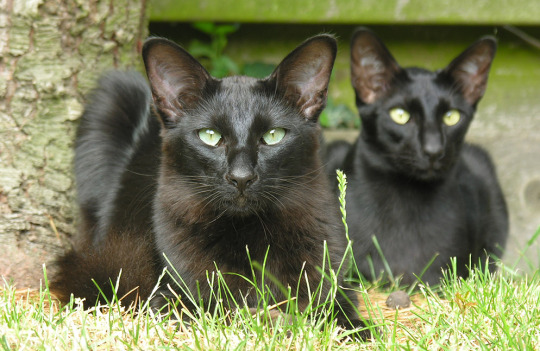
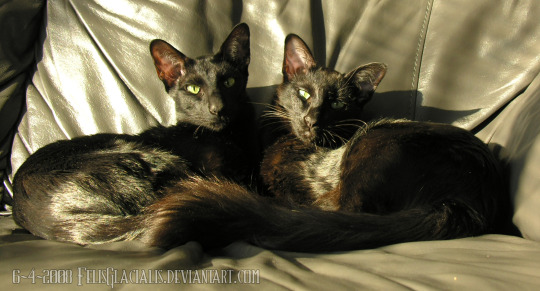
youtube
When Nintu died on May 7th 2020 at an age of almost 14, Neo missed his buddy so much that we adopted Yuka, a red ‘regular’ cat. He gave Neo some proper distraction with his naughtiness - hence his nickname “Geboefte” , which means criminal in Dutch.

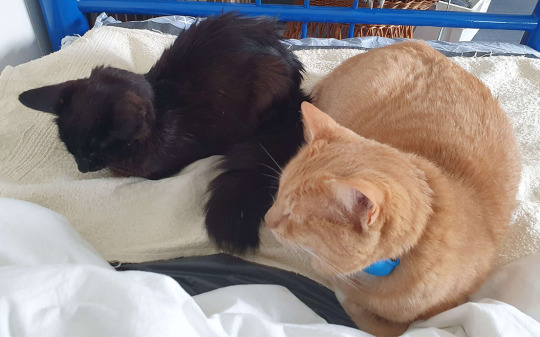

Neo was one of the loveliest, social and most easy going cats whom I’ve known. He was timid and careful but also the most talkative and intimate. Cuddles were almost always welcome and most led to roll and belly-rub session. He had the peculiar habit to do ‘stairs sticky’ as we called it: he stood on the first or 2nd floor while you had to stand a few steps lower on the stairs with your face was at his level and cuddle him.
We often gently joked about his funny look and mannerisms. He was exceptionally small (3.5 kg at max) for a tomcat, always had a bony butt, a pronounced sternum bone that stuck out and a lean but well filled ‘sack of organs’ along with a slightly kinked tail tip. Despite his small size, his paws were proportionally huge, which was not a desired trait for the breed - but I didn’t care; I love big paws. He had a very typical quiet, calm and elegant gait with small steps and an elevated head. Quite the opposite of Nintu’s big steps and -always-in-a-rush- pace. Neo and the other Oriental cats have left us so many precious memories. These will always remain.


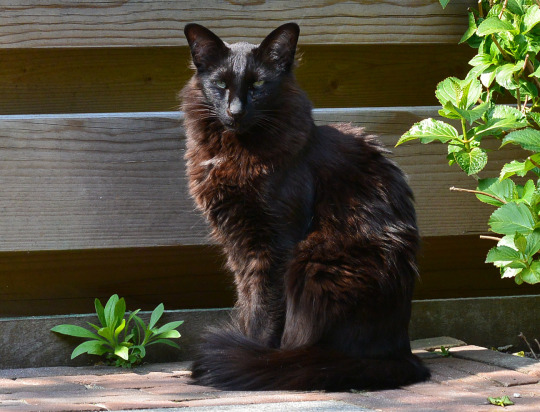

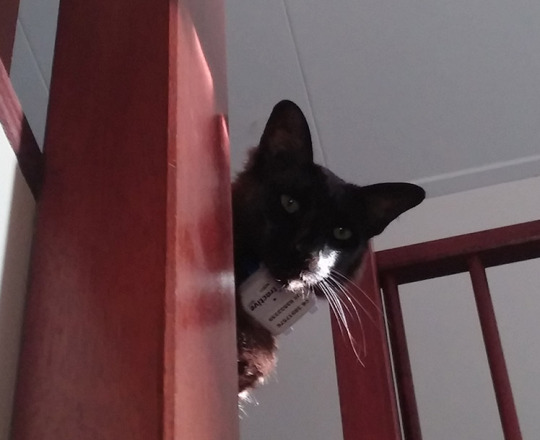
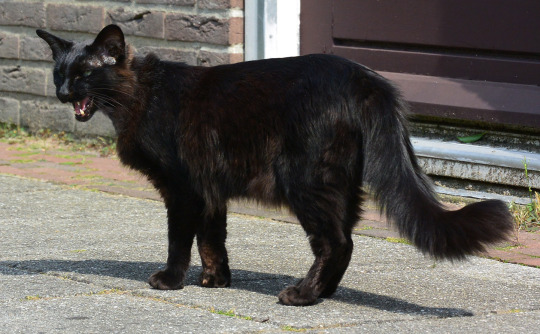
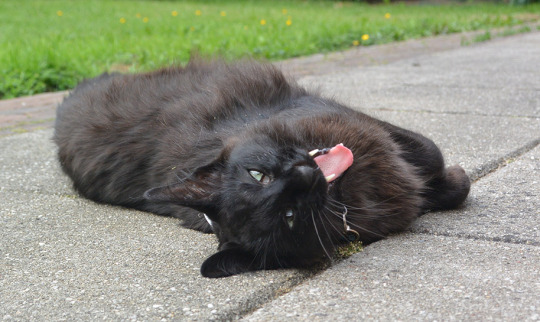

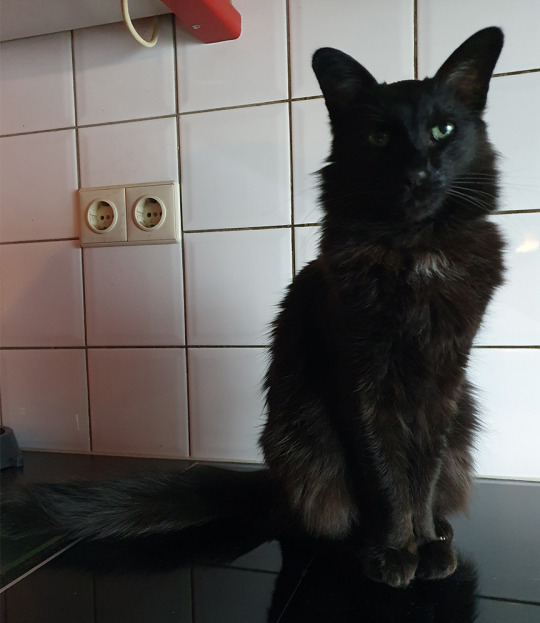

Neo was also the last Feline with whom I had an intimate bond. Since I moved out of my parents’ house in 2012. I was not physically living with him anymore but I came back regularly and Neo was always there to be ‘sticky’ again. Until now. The next time I’m going back, he won’t be there anymore.
But his spirit stays
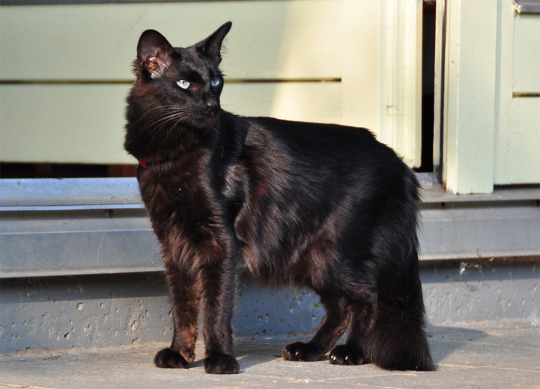
#Neo#end of an era#Oriental Longhair#my Feline friend#Mandarin#Javanese#Oriental cat#Black#Ebony#Youtube
14 notes
·
View notes
Text
List of Gods, most of which are no longer worshipped. via /r/atheism
List of Gods, most of which are no longer worshipped.
Middle-East
A, Adad, Adapa, Adrammelech, Aeon, Agasaya, Aglibol, Ahriman, Ahura Mazda, Ahurani, Ai-ada, Al-Lat, Aja, Aka, Alalu, Al-Lat, Amm, Al-Uzza (El-'Ozza or Han-Uzzai), An, Anahita, Anath (Anat), Anatu, Anbay, Anshar, Anu, Anunitu, An-Zu, Apsu, Aqhat, Ararat, Arinna, Asherali, Ashnan, Ashtoreth, Ashur, Astarte, Atar, Athirat, Athtart, Attis, Aya, Baal (Bel), Baalat (Ba'Alat), Baau, Basamum, Beelsamin, Belit-Seri, Beruth, Borak, Broxa, Caelestis, Cassios, Lebanon, Antilebanon, and Brathy, Chaos, Chemosh, Cotys, Cybele, Daena, Daevas, Dagon, Damkina, Dazimus, Derketo, Dhat-Badan, Dilmun, Dumuzi (Du'uzu), Duttur, Ea, El, Endukugga, Enki, Enlil, Ennugi, Eriskegal, Ereshkigal (Allatu), Eshara, Eshmun, Firanak, Fravashi, Gatamdug, Genea, Genos, Gestinanna, Gula, Hadad, Hannahanna, Hatti, Hea, Hiribi, The Houri, Humban, Innana, Ishkur, Ishtar, Ithm, Jamshid or Jamshyd, Jehovah, Jesus, Kabta, Kadi, Kamrusepas, Ki (Kiki), Kingu, Kolpia, Kothar-u-Khasis, Lahar, Marduk, Mari, Meni, Merodach, Misor, Moloch, Mot, Mushdama, Mylitta, Naamah, Nabu (Nebo), Nairyosangha, Nammu, Namtaru, Nanna, Nebo, Nergal, Nidaba, Ninhursag or Nintu, Ninlil, Ninsar, Nintur, Ninurta, Pa, Qadshu, Rapithwin, Resheph (Mikal or Mekal), Rimmon, Sadarnuna, Shahar, Shalim, Shamish, Shapshu, Sheger, Sin, Siris (Sirah), Taautos, Tammuz, Tanit, Taru, Tasimmet, Telipinu, Tiamat, Tishtrya, Tsehub, Utnapishtim, Utu, Wurusemu, Yam, Yarih (Yarikh), Yima, Zaba, Zababa, Zam, Zanahary (Zanaharibe), Zarpandit, Zarathustra, Zatavu, Zazavavindrano, Ziusudra, Zu (Imdugud), Zurvan
China:
Ba, Caishen, Chang Fei, Chang Hsien, Chang Pan, Ch'ang Tsai, Chao san-Niang, Chao T'eng-k'ang, Chen Kao, Ch'eng Huang, Cheng San-Kung, Cheng Yuan-ho, Chi Po, Chien-Ti, Chih Jih, Chih Nii, Chih Nu, Ch'ih Sung-tzu, Ching Ling Tzu, Ch'ing Lung, Chin-hua Niang-niang, Chio Yuan-Tzu, Chou Wang, Chu Niao, Chu Ying, Chuang-Mu, Chu-jung, Chun T'i, Ch'ung Ling-yu, Chung Liu, Chung-kuei, Chung-li Ch'üan, Di Jun, Fan K'uei, Fei Lien, Feng Pho-Pho, Fengbo, Fu Hsing, Fu-Hsi, Fu-Pao, Gaomei, Guan Di, Hao Ch'iu, Heng-o, Ho Po (Ping-I), Hou Chi, Hou T'u, Hsi Ling-su, Hsi Shih, Hsi Wang Mu, Hsiao Wu, Hsieh T'ien-chun, Hsien Nung, Hsi-shen, Hsu Ch'ang, Hsuan Wen-hua, Huang Ti, Huang T'ing, Huo Pu, Hu-Shen, Jen An, Jizo Bosatsu, Keng Yen-cheng, King Wan, Ko Hsien-Weng, Kuan Ti, Kuan Ti, Kuei-ku Tzu, Kuo Tzu-i, Lai Cho, Lao Lang, Lei Kung, Lei Tsu, Li Lao-chun, Li Tien, Liu Meng, Liu Pei, Lo Shen, Lo Yu, Lo-Tsu Ta-Hsien, Lu Hsing, Lung Yen, Lu-pan, Ma-Ku, Mang Chin-i, Mang Shen, Mao Meng, Men Shen, Miao Hu, Mi-lo Fo, Ming Shang, Nan-chi Hsien-weng, Niu Wang, Nu Wa, Nu-kua, Pa, Pa Cha, Pai Chung, Pai Liu-Fang, Pai Yu, P'an Niang, P'an-Chin-Lien, Pao Yuan-ch'uan, Phan Ku, P'i Chia-Ma, Pien Ho, San Kuan, Sao-ch'ing Niang, Sarudahiko, Shang Chien, Shang Ti, She chi, Shen Hsui-Chih, Shen Nung, Sheng Mu, Shih Liang, Shiu Fang, Shou-lao, Shun I Fu-jen, Sien-Tsang, Ssu-ma Hsiang-ju, Sun Pin, Sun Ssu-miao, Sung-Chiang, Tan Chu, T'ang Ming Huang, Tao Kung, T'ien Fei, Tien Hou, Tien Mu, Ti-tsang, Tsai Shen, Ts'an Nu, Ts'ang Chien, Tsao Chun, Tsao-Wang, T'shai-Shen, Tung Chun, T'ung Chung-chung, T'ung Lai-yu, Tung Lu, T'ung Ming, Tzu-ku Shen, Wa, Wang Ta-hsien, Wang-Mu-Niang-Niang, Weiwobo, Wen-ch'ang, Wu-tai Yuan-shuai, Xi Hou, Xi Wangmu, Xiu Wenyin, Yanwang, Yaoji, Yen-lo, Yen-Lo-Wang, Yi, Yu, Yu Ch'iang, Yu Huang, Yun-T'ung, Yu-Tzu, Zaoshen, Zhang Xi, , Zhinü, , Zhongguei, , Zigu Shen, , Zisun, Ch'ang-O
Slavic:
Aba-khatun, Aigiarm, Ajysyt, Alkonost, Almoshi, Altan-Telgey, Ama, Anapel, As-ava, Ausaitis, Austeja, Ayt'ar, Baba Yaga (Jezi Baba), Belobog (Belun), Boldogasszony, Breksta, Bugady Musun, Chernobog (Crnobog, Czarnobog, Czerneboch, Cernobog), Cinei-new, Colleda (Koliada), Cuvto-ava, Dali, Darzu-mate, Dazhbog, Debena, Devana, Diiwica (Dilwica), Doda (Dodola), Dolya, Dragoni, Dugnai, Dunne Enin, Edji, Elena, Erce, Etugen, Falvara, The Fates, The Fatit, Gabija, Ganiklis, Giltine, Hotogov Mailgan, Hov-ava, Iarila, Isten, Ja-neb'a, Jedza, Joda-mate, Kaldas, Kaltes, Keretkun, Khadau, Khursun (Khors), Kostrubonko, Kovas, Krumine, Kupala, Kupalo, Laima, Leshy, Marina, Marzana, Matergabiae, Mat Syra Zemlya, Medeine, Menu (Menulis), Mir-Susne-Khum, Myesyats, Nastasija, (Russia) Goddess of sleep., Nelaima, Norov, Numi-Tarem, Nyia, Ora, Ot, Patollo, Patrimpas, Pereplut, Perkuno, Perun, Pikuolis, Pilnytis, Piluitus, Potrimpo, Puskaitis, Rod, Rugevit, Rultennin, Rusalki, Sakhadai-Noin, Saule, Semargl, Stribog, Sudjaje, Svantovit (Svantevit, Svitovyd), Svarazic (Svarozic, Svarogich), Tengri, Tñairgin, Triglav, Ulgen (Ulgan, Ülgön), Veles (Volos), Vesna, Xatel-Ekwa, Xoli-Kaltes, Yamm, Yarilo, Yarovit, Ynakhsyt, Zaria, Zeme mate, Zemyna, Ziva (Siva), Zizilia, Zonget, Zorya, Zvoruna, Zvezda Dennitsa, Zywie
Hindu
Aditi, Adityas, Ambika, Ananta (Shesha), Annapurna (Annapatni), Aruna, Ashvins, Balarama, Bhairavi, Brahma, Buddha, Dakini, Devi, Dharma, Dhisana, Durga, Dyaus, Ganesa (Ganesha), Ganga (Ganges), Garuda, Gauri, Gopis, Hanuman, Hari-Hara, Hulka Devi, Jagganath, Jyeshtha, Kama, Karttikeya, Krishna, Krtya, Kubera, Kubjika, Lakshmi or Laksmi, Manasha, Manu, Maya, Meru, Nagas, Nandi, Naraka, Nataraja, Nirriti, Parjanya, Parvati, Paurnamasi, Prithivi, Purusha, Radha, Rati, Ratri, Rudra, Sanjna, Sati, Shashti, Shatala, Sitala (Satala), Skanda, Sunrta, Surya, Svasti-devi, Tvashtar, Uma, Urjani, Vach, Varuna, Vayu, Vishnu (Avatars of Vishnu: Matsya; Kurma; Varaha; Narasinha; Vamana; Parasurama; Rama; Krishna; Buddha; Kalki), Vishvakarman, Yama, Sraddha
Japan: Aji-Suki-Taka-Hi-Kone, Ama no Uzume, Ama-terasu, Amatsu Mikaboshi, Benten (Benzai-Ten), Bishamon, Chimata-No-Kami, Chup-Kamui, Daikoku, Ebisu, Emma-O, Fudo, Fuji, Fukurokuju, Gekka-O, Hachiman, Hettsui-No-Kami, Ho-Masubi, Hotei, Inari, Izanagi and Izanami, Jizo Bosatsu, Jurojin, Kagutsuchi, Kamado-No-Kami, Kami, Kawa-No-Kami, Kaya-Nu-Hima, Kishijoten, Kishi-Mojin, Kunitokotatchi, Marici, Monju-Bosatsu, Nai-No-Kami, No-Il Ja-Dae, O-Kuni-Nushi, Omoigane, Raiden, Shine-Tsu-Hiko, Shoten, Susa-no-wo, Tajika-no-mikoto, Tsuki-yomi, Uka no Mitanna, Uke-mochi, Uso-dori, Uzume, Wakahirume, Yainato-Hnneno-Mikoi, Yama-No-Kami, Yama-no-Karni, Yaya-Zakurai, Yuki-Onne
India
Agni, Ammavaru, Asuras, Banka-Mundi, Brihaspati, Budhi Pallien, Candi, Challalamma, Chinnintamma, Devas, Dyaush, Gauri-Sankar, Grhadevi, Gujeswari, Indra, Kali, Lohasur Devi, Mayavel, Mitra, Prajapati, Puchan, Purandhi, Rakshas, Rudrani, Rumina, Samundra, Sarasvati, Savitar, Siva (Shiva), Soma, Sura, Surabhi, Tulsi, Ushas, Vata, Visvamitra, Vivasvat, Vritra, Waghai Devi, Yaparamma, Yayu, Zumiang Nui, Diti
Other Asian: Dewi Shri, Po Yan Dari, Shuzanghu, Antaboga, Yakushi Nyorai, Mulhalmoni, Tankun, Yondung Halmoni, Aryong Jong, Quan Yin , Tengri, Uminai-gami, Kamado-No-Kami, Kunitokotatchi, Giri Devi, Dewi Nawang Sasih, Brag-srin-mo, Samanta-Bhadra, Sangs-rgyas-mkhá, Sengdroma, Sgeg-mo-ma, Tho-og, Ui Tango, Yum-chen-mo, Zas-ster-ma-dmar-mo, Chandra, Dyaus, Ratri, Rodasi, Vayu, Au-Co
African Gods, Demigods and First Men:
Abassi , Abuk , Adu Ogyinae , Agé , Agwe , Aida Wedo , Ajalamo, Aje, Ajok, Akonadi, Akongo, Akuj, Amma, Anansi, Asase Yaa, Ashiakle, Atai , Ayaba, Aziri, Baatsi, Bayanni, Bele Alua, Bomo rambi, Bosumabla, Buk, Buku, Bumba, Bunzi, Buruku, Cagn, Candit, Cghene, Coti, Damballah-Wedo, Dan, Deng, Domfe, Dongo, Edinkira, Efé, Egungun-oya, Eka Abassi, Elephant Girl Mbombe, Emayian, Enekpe, En-Kai, Eseasar, Eshu, Esu, Fa, Faran, Faro, Fatouma, Fidi Mukullu, Fon, Gleti, Gonzuole, Gû, Gua, Gulu, Gunab, Hammadi, Hêbiesso, Iku, Ilankaka, Imana, Iruwa, Isaywa, Juok, Kazooba, Khakaba, Khonvum, Kibuka, Kintu, Lebé, Leza, Libanza, Lituolone, Loko, Marwe, Massim Biambe, Mawu-Lisa (Leza), Mboze, Mebeli, Minepa, Moombi, Mukameiguru, Mukasa, Muluku, Mulungu, Mwambu, Nai, Nambi, Nana Buluku, Nanan-Bouclou, Nenaunir, Ng Ai, Nyaliep, Nyambé, Nyankopon, Nyasaye, Nzame, Oboto, Obumo, Odudua-Orishala, Ogun, Olokun, Olorun, Orisha Nla, Orunmila, Osanyin, Oshe, Osun, Oya, Phebele, Pokot-Suk, Ralubumbha, Rugaba, Ruhanga, Ryangombe, Sagbata, Shagpona, Shango, Sopona, Tano, Thixo, Tilo, Tokoloshi, Tsui, Tsui'goab, Umvelinqangi, Unkulunkulu, Utixo, Wak, Wamara, Wantu Su, Wele, Were, Woto, Xevioso, Yangombi, Yemonja, Ymoa, Ymoja, Yoruba, Zambi, Zanahary , Zinkibaru
Australian Gods, Goddesses and Places in the Dreamtime:
Alinga, Anjea, Apunga, Arahuta, Ariki, Arohirohi, Bamapana, Banaitja, Bara, Barraiya, Biame, Bila, Boaliri, Bobbi-bobbi, Bunbulama, Bunjil, Cunnembeille, Daramulum, Dilga, Djanggawul Sisters, Eingana, Erathipa, Gidja , Gnowee, Haumia, Hine Titama, Ingridi, Julana, Julunggul, Junkgowa, Karora, Kunapipi-Kalwadi-Kadjara, Lia, Madalait, Makara, Nabudi, Palpinkalare, Papa, Rangi, Rongo, Tane, Tangaroa, Tawhiri-ma-tea, Tomituka, Tu, Ungamilia, Walo, Waramurungundi, Wati Kutjarra, Wawalag Sisters, Wuluwaid, Wuragag, Wuriupranili, Wurrunna, Yhi
Buddhism, Gods and Relatives of God:
Aizen-Myoo, Ajima,Dai-itoku-Myoo, Fudo-Myoo, Gozanze-Myoo, Gundari-Myoo, Hariti, Kongo-Myoo, Kujaku-Myoo, Ni-O
Carribean: Gods, Monsters and Vodun Spirits
Agaman Nibo , Agwe, Agweta, Ah Uaynih, Aida Wedo , Atabei , Ayida , Ayizan, Azacca, Baron Samedi, Ulrich, Ellegua, Ogun, Ochosi, Chango, Itaba, Amelia, Christalline, Clairmé, Clairmeziné, Coatrischie, Damballah , Emanjah, Erzuli, Erzulie, Ezili, Ghede, Guabancex, Guabonito, Guamaonocon, Imanje, Karous, Laloue-diji, Legba, Loa, Loco, Maitresse Amelia , Mapiangueh, Marie-aimée, Marinette, Mombu, Marassa, Nana Buruku, Oba, Obtala, Ochu, Ochumare, Oddudua, Ogoun, Olokum, Olosa, Oshun, Oya, Philomena, Sirêne, The Diablesse, Itaba, Tsilah, Ursule, Vierge, Yemaya , Zaka
Celtic: Gods, Goddesses, Divine Kings and Pagan Saints
Abarta, Abna, Abnoba, Aine, Airetech,Akonadi, Amaethon, Ameathon, An Cailleach, Andraste, Antenociticus, Aranrhod, Arawn, Arianrod, Artio, Badb,Balor, Banbha, Becuma, Belatucadros, Belatu-Cadros, Belenus, Beli,Belimawr, Belinus, Bendigeidfran, Bile, Blathnat, Blodeuwedd, Boann, Bodus,Bormanus, Borvo, Bran, Branwen, Bres, Brigid, Brigit, Caridwen, Carpantus,Cathbadh, Cecht, Cernach, Cernunnos, Cliodna, Cocidius, Conchobar, Condatis, Cormac,Coronus,Cosunea, Coventina, Crarus,Creidhne, Creirwy, Cu Chulainn, Cu roi, Cuda, Cuill,Cyhiraeth,Dagda, Damona, Dana, Danu, D'Aulnoy,Dea Artio, Deirdre , Dewi, Dian, Diancecht, Dis Pater, Donn, Dwyn, Dylan, Dywel,Efnisien, Elatha, Epona, Eriu, Esos, Esus, Eurymedon,Fedelma, Fergus, Finn, Fodla, Goewyn, Gog, Goibhniu, Govannon , Grainne, Greine,Gwydion, Gwynn ap Nudd, Herne, Hu'Gadarn, Keltoi,Keridwen, Kernunnos,Ler, Lir, Lleu Llaw Gyffes, Lludd, Llyr, Llywy, Luchta, Lug, Lugh,Lugus, Mabinogion,Mabon, Mac Da Tho, Macha, Magog, Manannan, Manawydan, Maponos, Math, Math Ap Mathonwy, Medb, Moccos,Modron, Mogons, Morrig, Morrigan, Nabon,Nantosuelta, Naoise, Nechtan, Nedoledius,Nehalennia, Nemhain, Net,Nisien, Nodens, Noisi, Nuada, Nwywre,Oengus, Ogma, Ogmios, Oisin, Pach,Partholon, Penard Dun, Pryderi, Pwyll, Rhiannon, Rosmerta, Samhain, Segidaiacus, Sirona, Sucellus, Sulis, Taliesin, Taranis, Teutates, The Horned One,The Hunt, Treveni,Tyne, Urien, Ursula of the Silver Host, Vellaunus, Vitiris, White Lady
Egyptian: Gods, Gods Incarnate and Personified Divine Forces:
Amaunet, Amen, Amon, Amun, Anat, Anqet, Antaios, Anubis, Anuket, Apep, Apis, Astarte, Aten, Aton, Atum, Bastet, Bat, Buto, Duamutef, Duamutef, Hapi, Har-pa-khered, Hathor, Hauhet, Heket, Horus, Huh, Imset, Isis, Kauket, Kebechsenef, Khensu, Khepri, Khnemu, Khnum, Khonsu, Kuk, Maahes, Ma'at, Mehen, Meretseger, Min, Mnewer, Mut, Naunet, Nefertem, Neith, Nekhbet, Nephthys, Nun, Nut, Osiris, Ptah, Ra , Re, Renenet, Sakhmet, Satet, Seb, Seker, Sekhmet, Serapis, Serket, Set, Seth, Shai, Shu, Shu, Sia, Sobek, Sokar, Tefnut, Tem, Thoth
Hellenes (Greek) Tradition (Gods, Demigods, Divine Bastards)
Acidalia, Aello, Aesculapius, Agathe, Agdistis, Ageleia, Aglauros, Agne, Agoraia, Agreia, Agreie, Agreiphontes, Agreus, Agrios, Agrotera, Aguieus, Aidoneus, Aigiokhos, Aigletes, Aigobolos, Ainia,Ainippe, Aithuia , Akesios, Akraia, Aktaios, Alalkomene, Alasiotas, Alcibie, Alcinoe, Alcippe, Alcis,Alea, Alexikakos, Aligena, Aliterios, Alkaia, Amaltheia, Ambidexter, Ambologera, Amynomene,Anaduomene, Anaea, Anax, Anaxilea, Androdameia,Andromache, Andromeda, Androphonos, Anosia, Antandre,Antania, Antheus, Anthroporraistes, Antianara, Antianeira, Antibrote, Antimache, Antimachos, Antiope,Antiopeia, Aoide, Apatouria, Aphneius, Aphrodite, Apollo, Apotropaios, Areia, Areia, Areion, Areopagite, Ares, Areto, Areximacha,Argus, Aridnus,Aristaios, Aristomache, Arkhegetes, Arktos, Arretos, Arsenothelys, Artemis, Asclepius, Asklepios, Aspheleios, Asteria, Astraeos , Athene, Auxites, Avaris, Axios, Axios Tauros,Bakcheios, Bakchos, Basileus, Basilis, Bassareus, Bauros, Boophis, Boreas , Botryophoros, Boukeros, Boulaia, Boulaios, Bremusa,Bromios, Byblis,Bythios, Caliope, Cedreatis, Celaneo, centaur, Cerberus, Charidotes, Charybdis, Chimera, Chloe, Chloris , Choreutes, Choroplekes, Chthonios, Clete, Clio, clotho,Clyemne, cockatrice, Crataeis, Custos, Cybebe, Cybele, Cyclops, Daphnaia, Daphnephoros, Deianeira, Deinomache, Delia, Delios, Delphic, Delphinios, Demeter, Dendrites, Derimacheia,Derinoe, Despoina, Dikerotes, Dimeter, Dimorphos, Dindymene, Dioktoros, Dionysos, Discordia, Dissotokos, Dithyrambos, Doris, Dryope,Echephyle,Echidna, Eiraphiotes, Ekstatophoros, Eleemon, Eleuthereus, Eleutherios, Ennosigaios, Enodia, Enodios, Enoplios, Enorches, Enualios, Eos , Epaine, Epidotes, Epikourios, Epipontia, Epitragidia, Epitumbidia, Erato, Ergane, Eribromios, Erigdoupos, Erinus, Eriobea, Eriounios, Eriphos, Eris, Eros,Euanthes, Euaster, Eubouleus, Euboulos, Euios, Eukhaitos, Eukleia, Eukles, Eumache, Eunemos, Euplois, Euros , Eurybe,Euryleia, Euterpe, Fates,Fortuna, Gaia, Gaieokhos, Galea, Gamelia, Gamelios, Gamostolos, Genetor, Genetullis, Geryon, Gethosynos, giants, Gigantophonos, Glaukopis, Gorgons, Gorgopis, Graiae, griffin, Gynaikothoinas, Gynnis, Hagisilaos, Hagnos, Haides, Harmothoe, harpy, Hegemone, Hegemonios, Hekate, Hekatos, Helios, Hellotis, Hephaistia, Hephaistos, Hera, Heraios, Herakles, Herkeios, Hermes, Heros Theos, Hersos, Hestia, Heteira, Hiksios, Hipp, Hippia, Hippios, Hippoi Athanatoi, Hippolyte, Hippolyte II,Hippomache,Hippothoe, Horkos, Hugieia, Hupatos, Hydra, Hypate, Hyperborean, Hypsipyle, Hypsistos, Iakchos, Iatros, Idaia, Invictus, Iphito,Ismenios, Ismenus,Itonia, Kabeiria, Kabeiroi, Kakia, Kallinikos, Kallipugos, Kallisti, Kappotas, Karneios, Karpophoros, Karytis, Kataibates, Katakhthonios, Kathatsios, Keladeine, Keraunos, Kerykes, Khalinitis, Khalkioikos, Kharmon, Khera, Khloe, Khlori,Khloris,Khruse, Khthonia, Khthonios, Kidaria, Kissobryos, Kissokomes, Kissos, Kitharodos, Kleidouchos, Kleoptoleme, Klymenos, Kore, Koruthalia, Korymbophoros, Kourotrophos, Kranaia, Kranaios, Krataiis, Kreousa, Kretogenes, Kriophoros, Kronides, Kronos,Kryphios, Ktesios, Kubebe, Kupris, Kuprogenes, Kurotrophos, Kuthereia, Kybele, Kydoime,Kynthia, Kyrios, Ladon, Lakinia, Lamia, Lampter, Laodoke, Laphria, Lenaios, Leukatas, Leukatas, Leukolenos, Leukophruene, Liknites, Limenia, Limnaios, Limnatis, Logios, Lokhia, Lousia, Loxias, Lukaios, Lukeios, Lyaios, Lygodesma, Lykopis, Lyseus, Lysippe, Maimaktes, Mainomenos, Majestas, Makar, Maleatas, Manikos, Mantis, Marpe, Marpesia, Medusa, Megale, Meilikhios, Melaina, Melainis, Melanaigis, Melanippe,Melete, Melousa, Melpomene, Melqart, Meses, Mimnousa, Minotaur, Mneme, Molpadia,Monogenes, Morpho, Morychos, Musagates, Musagetes, Nebrodes, Nephelegereta, Nereus,Nete, Nike, Nikephoros, Nomios, Nomius, Notos , Nyktelios, Nyktipolos, Nympheuomene, Nysios, Oiketor, Okyale, Okypous, Olumpios, Omadios, Ombrios, Orithia,Orius,Ortheia, Orthos, Ourania, Ourios, Paelemona, Paian, Pais, Palaios, Pallas, Pan Megas, Panakhais, Pandemos, Pandrosos, Pantariste, Parthenos, PAsianax, Pasiphaessa, Pater, Pater, Patroo s, Pegasus, Pelagia, Penthesilea, Perikionios, Persephone, Petraios, Phanes, Phanter, Phatria, Philios, Philippis, Philomeides, Phoebe, Phoebus, Phoenix, Phoibos, Phosphoros, Phratrios, Phutalmios, Physis, Pisto, Plouton, Polemusa,Poliakhos, Polias, Polieus, Polumetis, Polydektes, Polygethes, Polymnia, Polymorphos, Polyonomos, Porne, Poseidon, Potnia Khaos, Potnia Pheron, Promakhos, Pronoia, Propulaios, Propylaia, Proserpine, Prothoe, Protogonos, Prytaneia, Psychopompos, Puronia, Puthios, Pyrgomache, Python, Rhea, Sabazios, Salpinx, satyr, Saxanus, Scyleia,Scylla, sirens, Skeptouchos, Smintheus, Sophia, Sosipolis, Soter, Soteria, Sphinx, Staphylos, Sthenias, Sthenios, Strife, Summakhia, Sykites, Syzygia, Tallaios, Taureos, Taurokeros, Taurophagos, Tauropolos, Tauropon, Tecmessa, Teisipyte, Teleios, Telepyleia,Teletarches, Terpsichore, Thalestris, Thalia, The Dioskouroi, Theos, Theritas, Thermodosa, Thraso, Thyonidas, Thyrsophoros, Tmolene, Toxaris, Toxis, Toxophile,Trevia, Tricephalus, Trieterikos, Trigonos, Trismegestos, Tritogeneia, Tropaios, Trophonius,Tumborukhos, Tyche, Typhon, Urania, Valasca, Xanthippe, Xenios, Zagreus, Zathos, Zephryos , Zeus, Zeus Katakhthonios, Zoophoros Topana
Native American: Gods, Heroes, and Anthropomorphized Facets of Nature
Aakuluujjusi, Ab Kin zoc, Abaangui , Ababinili , Ac Yanto, Acan, Acat, Achiyalatopa , Acna, Acolmiztli, Acolnahuacatl, Acuecucyoticihuati, Adamisil Wedo, Adaox , Adekagagwaa , Adlet , Adlivun, Agloolik , Aguara , Ah Bolom Tzacab, Ah Cancum, Ah Chun Caan, Ah Chuy Kak, Ah Ciliz, Ah Cun Can, Ah Cuxtal, Ah hulneb, Ah Kin, Ah Kumix Uinicob, Ah Mun, Ah Muzencab, Ah Patnar Uinicob, Ah Peku, Ah Puch, Ah Tabai, Ah UincirDz'acab, Ah Uuc Ticab, Ah Wink-ir Masa, Ahau Chamahez, Ahau-Kin, Ahmakiq, Ahnt Alis Pok', Ahnt Kai', Aholi , Ahsonnutli , Ahuic, Ahulane, Aiauh, Aipaloovik , Ajbit, Ajilee , Ajtzak, Akbaalia , Akba-atatdia , Akhlut , Akhushtal, Akna , Akycha, Alaghom Naom Tzentel, Albino Spirit animals , Alektca , Alignak, Allanque , Allowat Sakima , Alom, Alowatsakima , Amaguq , Amala , Amimitl, Amitolane, Amotken , Andaokut , Andiciopec , Anerneq , Anetlacualtiliztli, Angalkuq , Angpetu Wi, Anguta, Angwusnasomtaka , Ani Hyuntikwalaski , Animal spirits , Aningan, Aniwye , Anog Ite , Anpao, Apanuugak , Apicilnic , Apikunni , Apotamkin , Apoyan Tachi , Apozanolotl, Apu Punchau, Aqalax , Arendiwane , Arnakua'gsak , Asdiwal , Asgaya Gigagei, Asiaq , Asin , Asintmah, Atacokai , Atahensic, Aticpac Calqui Cihuatl, Atira, Atisokan , Atius Tirawa , Atl, Atlacamani, Atlacoya, Atlatonin, Atlaua, Atshen , Auilix, Aulanerk , Aumanil , Aunggaak , Aunt Nancy , Awaeh Yegendji , Awakkule , Awitelin Tsta , Awonawilona, Ayauhteotl, Azeban, Baaxpee , Bacabs, Backlum Chaam, Bagucks , Bakbakwalanooksiwae , Balam, Baldhead , Basamacha , Basket Woman , Bead Spitter , Bear , Bear Medicine Woman , Bear Woman , Beaver , Beaver Doctor , Big Heads, Big Man Eater , Big Tail , Big Twisted Flute , Bikeh hozho, Bitol, Black Hactcin , Black Tamanous , Blind Boy , Blind Man , Blood Clot Boy , Bloody Hand , Blue-Jay , Bmola , Bolontiku, Breathmaker, Buffalo , Buluc Chabtan, Burnt Belly , Burnt Face , Butterfly , Cabaguil, Cacoch, Cajolom, Cakulha, Camaxtli, Camozotz, Cannibal Grandmother , Cannibal Woman , Canotila , Capa , Caprakan, Ca-the-ña, Cauac, Centeotl, Centzonuitznaua, Cetan , Chac Uayab Xoc, Chac, Chahnameed , Chakwaina Okya, Chalchihuitlicue, Chalchiuhtlatonal, Chalchiutotolin, Chalmecacihuilt, Chalmecatl, Chamer, Changing Bear Woman , Changing Woman , Chantico, Chaob, Charred Body , Chepi , Chibiabos ,Chibirias, Chiccan, Chicomecoatl, Chicomexochtli, Chiconahui, Chiconahuiehecatl, Chie, Child-Born-in-Jug , Chirakan, Chulyen , Cihuacoatl, Cin-an-ev , Cinteotl, Cipactli, Cirapé , Cit Chac Coh, Cit-Bolon-Tum, Citlalatonac, Citlalicue, Ciucoatl, Ciuteoteo, Cizin, Cliff ogre , Coatlicue, Cochimetl, Cocijo, Colel Cab, Colop U Uichkin, Copil, Coyolxauhqui, Coyopa, Coyote , Cripple Boy , Crow , Crow Woman , Cum hau, Cunawabi , Dagwanoenyent , Dahdahwat , Daldal , Deohako, Dhol , Diyin dine , Djien , Djigonasee , Dohkwibuhch , Dzalarhons , Dzalarhons, Eagentci , Eagle , Earth Shaman , Eeyeekalduk , Ehecatl, Ehlaumel , Eithinoha , Ekchuah, Enumclaw , Eototo, Esaugetuh Emissee , Esceheman, Eschetewuarha, Estanatlehi , Estasanatlehi , Estsanatlehi, Evaki, Evening Star, Ewah , Ewauna, Face , Faces of the Forests , False Faces , Famine , Fastachee , Fire Dogs , First Creator , First Man and First Woman, First Scolder , Flint Man , Flood , Flower Woman , Foot Stuck Child , Ga'an, Ga-gaah , Gahe, Galokwudzuwis , Gaoh, Gawaunduk, Geezhigo-Quae, Gendenwitha, Genetaska, Ghanan, Gitche Manitou, Glispa, Glooskap , Gluscabi , Gluskab , Gluskap, Godasiyo, Gohone , Great Seahouse, Greenmantle , Gucumatz, Gukumatz, Gunnodoyak, Gyhldeptis, Ha Wen Neyu , Hacauitz , Hacha'kyum, Hagondes , Hahgwehdiyu , Hamatsa , Hamedicu, Hanghepi Wi, Hantceiitehi , Haokah , Hastseoltoi, Hastshehogan , He'mask.as , Hen, Heyoka , Hiawatha , Hino, Hisakitaimisi, Hokhokw , Hotoru, Huehuecoyotl, Huehueteotl, Huitaca , Huitzilopochtli, Huixtocihuatl, Hummingbird, Hun hunahpu, Hun Pic Tok, Hunab Ku, Hunahpu Utiu, Hunahpu, Hunahpu-Gutch, Hunhau, Hurakan, Iatiku And Nautsiti, Ich-kanava , Ictinike , Idliragijenget , Idlirvirisong, Igaluk , Ignirtoq , Ikanam , Iktomi , Ilamatecuhtli, Illapa, Ilya p'a, i'noGo tied , Inti, Inua , Ioskeha , Ipalnemohuani, Isakakate, Ishigaq , Isitoq , Issitoq , Ite , Itzamná, Itzananohk`u, Itzlacoliuhque, Itzli, Itzpapalotl, Ix Chebel Yax, Ixbalanque, Ixchel, Ixchup, Ixmucane, Ixpiyacoc, Ixtab, Ixtlilton, Ixtubtin, Ixzaluoh, Iya , Iyatiku , Iztaccihuatl, Iztacmixcohuatl, Jaguar Night, Jaguar Quitze, Jogah , Kaakwha , Kabun , Kabun , Kachinas, Kadlu , Ka-Ha-Si , Ka-Ha-Si , Kaik , Kaiti , Kan, Kana'ti and Selu , Kanati, Kan-u-Uayeyab, Kan-xib-yui, Kapoonis , Katsinas, Keelut , Ketchimanetowa, Ketq Skwaye, Kianto, Kigatilik , Kilya, K'in, Kinich Ahau, Kinich Kakmo, Kishelemukong , Kisin, Kitcki Manitou, Kmukamch , Kokopelli , Ko'lok , Kukulcan, Kushapatshikan , Kutni , Kutya'I , Kwakwakalanooksiwae ,Kwatee , Kwekwaxa'we , Kwikumat , Kyoi , Lagua , Land Otter People , Lawalawa , Logobola , Loha, Lone Man , Long Nose , Loon , Loon Medicine , Loon Woman , Loo-wit, Macaw Woman, Macuilxochitl, Maho Peneta, Mahucutah, Makenaima , Malesk , Malina , Malinalxochi, Malsum, Malsumis , Mam, Mama Cocha, Man in moon , Manabozho , Manetuwak , Mani'to, Manitou , Mannegishi , Manu, Masaya, Masewi , Master of Life , Master Of Winds, Matshishkapeu , Mavutsinim , Mayahuel, Medeoulin , Mekala , Menahka, Meteinuwak , Metztli, Mexitl, Michabo, Mictecacihuatl, Mictlan, Mictlantecuhtli, Mikchich , Mikumwesu , Mitnal, Mixcoatl, Mongwi Kachinum , Morning Star, Motho and Mungo , Mulac, Muut , Muyingwa , Nacon, Nagenatzani, Nagi Tanka , Nagual, Nahual, Nakawé, Nanabojo, Nanabozho , Nanabush, Nanahuatzin, Nanautzin, Nanih Waiya, Nankil'slas , Nanook , Naum, Negafook , Nerrivik , Nesaru, Nianque , Nishanu , Nohochacyum, Nokomis, Nootaikok , North Star, Nujalik , Nukatem , Nunne Chaha , Ocasta, Ockabewis, Odzihozo , Ohtas , Oklatabashih, Old Man , Olelbis, Omacatl, Omecihuatl, Ometecuhtli, Onatha , One Tail of Clear Hair , Oonawieh Unggi , Opochtli, Oshadagea, Owl Woman , Pah , Pah, Paiowa, Pakrokitat , Pana , Patecatl, Pautiwa, Paynal, Pemtemweha , Piasa , Pikváhahirak , Pinga , Pomola , Pot-tilter , Prairie Falcon , Ptehehincalasanwin , Pukkeenegak , Qaholom, Qakma, Qiqirn , Quaoar , Quetzalcoatl, Qumu , Quootis-hooi, Rabbit, Ragno, Raven, Raw Gums , Rukko, Sagamores , Sagapgia , Sanopi , Saynday , Sedna, Selu, Shakuru, Sharkura, Shilup Chito Osh, Shrimp house, Sila , Sint Holo , Sio humis, Sisiutl , Skan , Snallygaster , Sosondowah , South Star, Spider Woman , Sta-au , Stonecoats , Sun, Sungrey , Ta Tanka , Tabaldak , Taime , Taiowa , Talocan, Tans , Taqwus , Tarhuhyiawahku, Tarquiup Inua , Tate , Tawa, Tawiscara, Ta'xet , Tcisaki , Tecciztecatl, Tekkeitserktock, Tekkeitsertok , Telmekic , Teoyaomqui, Tepeu, Tepeyollotl, Teteoinnan, Tezcatlipoca, Thobadestchin, Thoume', Thunder , Thunder Bird , Tieholtsodi, Tihtipihin , Tirawa , Tirawa Atius, Tlacolotl, Tlahuixcalpantecuhtli, Tlaloc, Tlaltecuhtli, Tlauixcalpantecuhtli, Tlazolteotl, Tohil, Tokpela ,Tonantzin , Tonatiuh, To'nenile, Tonenili , Tootega , Torngasak, Torngasoak , Trickster/Transformer , True jaguar, Tsentsa, Tsichtinako, Tsohanoai Tsonoqwa , Tsul 'Kalu , Tulugaak , Tumas , Tunkan ingan, Turquoise Boy , Twin Thunder Boys, Txamsem , Tzakol, Tzitzimime, Uazzale , Uchtsiti, Udó , Uentshukumishiteu , Ueuecoyotl, Ugly Way , Ugni , Uhepono , Uitzilopochtli, Ukat , Underwater Panthers , Unhcegila , Unipkaat , Unk, Unktomi , Untunktahe , Urcaguary, Utea , Uwashil , Vassagijik , Voltan, Wabosso , Wabun , Wachabe, Wah-Kah-Nee, Wakan , Wakanda , Wakan-Tanka, Wakinyan , Wan niomi , Wanagi , Wananikwe , Watavinewa , Water babies , Waukheon , We-gyet , Wemicus , Wendigo , Wentshukumishiteu , White Buffalo Woman, Whope , Wi , Wicahmunga , Wihmunga , Windigo, Winonah, Wisagatcak , Wisagatcak, Wishpoosh , Wiyot , Wovoka , Wuya , Xaman Ek, Xelas , Xibalba, Xilonen, Xipe Totec, Xiuhcoatl, Xiuhtecuhtli, Xiuhtecutli, Xmucane, Xochipili , Xochiquetzal, Xocotl, Xolotl, Xpiyacoc, Xpuch And Xtah, Yacatecuhtli, Yaluk, Yanauluha , Ya-o-gah , Yeba Ka, Yebaad, Yehl , Yeitso, Yiacatecuhtli, Yolkai Estsan, Yoskeha , Yum Kaax, Yuwipi , Zaramama, Zipaltonal, Zotz
Norse Deities, Giants and Monsters:
Aegir, Aesir, Alfrigg, Audumbla, Aurgelmir, Balder, Berchta, Bergelmir, Bor, Bragi, Brisings, Buri, Etin, Fenris, Forseti, Frey, Freyja, Frigga, Gefion, Gerda, Gode, Gymir, Harke, Heimdall, Hel, Hermod, Hodur, Holda, Holle, Honir, Hymir, Idun, Jormungandr, Ljolsalfs, Loki, Magni, Mimir, Mistarblindi, Muspel, Nanna, Nanni, Nerthus, Njord, Norns, Odin, Perchta, Ran, Rig, Segyn, Sif, Skadi, Skirnir, Skuld, Sleipnir, Surt, Svadilfari, tanngniotr, tanngrisnr, Thiassi, Thor, Thrud, Thrudgelmir, Thrym, Thurs, Tyr, Uller, Urd, Vali, Vali, Valkyries, Vanir, Ve, Verdandi, Vidar, Wode, Ymir
Pacific islands: Deities, Demigods and Immortal Monsters:
Abeguwo, Abere, Adaro, Afekan, Ai Tupua'i, 'Aiaru, Ala Muki, Alalahe, Alii Menehune, Aluluei, Aruaka, Asin, Atanea, Audjal, Aumakua, Babamik, Bakoa, Barong, Batara Kala, Buring Une, Darago, Dayang-Raca, De Ai, Dogai, Enda Semangko, Faumea, Giriputri, Goga, Haumea, Hiiaka', Hina, Hine, Hoa-Tapu, 'Imoa, Io, Kanaloa, Kanaloa, Kane, Kapo, Kava, Konori, Ku, Kuhuluhulumanu, Kuklikimoku, Kukoae, Ku'ula, Laka, Laulaati, Lono, Mahiuki, MakeMake, Marruni, Maru, Maui, Melu, Menehune, Moeuhane, MOO-LAU, Ndauthina, Ne Te-reere, Nevinbimbaau, Ngendei, Nobu, Oro, Ove, Paka'a, Papa, Pele, Quat, Rangi, Rati, Rati-mbati-ndua, Ratu-Mai-Mbula, Rua, Ruahatu, Saning Sri, Ta'aroa, Taaroa, Tamakaia, Tane, Tanemahuta, Tangaroa, Tawhaki, Tiki, Tinirau, Tu, Tuli, Turi-a-faumea, Uira, Ukupanipo, Ulupoka, Umboko Indra, Vanuatu, Wahini-Hal, Walutahanga, Wari-Ma-Te-Takere, Whaitiri, Whatu, Wigan
South American: Deities, Demigods, Beings of Divine Substance:
Abaangui, Aclla, Akewa, Asima Si, Atoja, Auchimalgen, Axomama, Bachué, Beru, Bochica, Boiuna, Calounger, Catequil, Cavillaca, Ceiuci, Chasca, Chie, Cocomama, Gaumansuri, Huitaca, Iae, Ilyap'a, Ina, Inti, Ituana, Jamaina , Jandira, Jarina, Jubbu-jang-sangne, Ka-ata-killa, Kilya, Kuat, Kun, Luandinha, Lupi, Mama Allpa, Mama Quilla, Mamacocha, Manco Capac, Maret-Jikky, Maretkhmakniam, Mariana, Oshossi, Pachamac, Pachamama, Perimbó, Rainha Barba, Si, Supai, Topétine, Viracocha, Yemanja (Imanje), Zume
Submitted May 28, 2023 at 04:42PM by dreamer100__
(From Reddit https://ift.tt/uTlQcN4)
19 notes
·
View notes
Text
Writing and surveying were essential to the existence of urban civilization, and Nisaba is thereby honored as the one who makes cities possible: “the place which you do not establish, there humankind is not established, cities are not built.” Other goddesses were also involved in such learned occupations. Amageshtinanna, who composed laments for her dead brother Dumuzi, was also called "mistress of scribes, and the goddess Nintu is also called the "great knower who knows everything." But it was primarily Nisaba who filled this role, honored by the scribes who ended their compositions with the short sentence, "Nisaba be praised!"
The scribes praising Nisaba were generally male. Why, then, did they imagine their profession to be under the tutelage of a female? And why did the singers and healers, many of whom were also men, pray to and praise their patron goddesses? The answer lies in the skilled nature of these activities and the contribution of women to their development. The cultural arts are learned occupations which require the accumulation of technological knowledge. They are wise activities and, as such, are attributed to wise women. Part of the reason that women were considered wise is psychological, for women were the chief caretakers of nursing children. This meant that the child developed in the presence of what seemed to her an all-knowing, all-powerful mother of early childhood, the "goddess of the nursery." There is another historical factor that should not be overlooked. Men were engaged in strenuous large-muscle occupations for which their superior upper-arm strength and generally heavier musculature was needed. In early Mesopotamia, they spent their time ploughing with oxen, digging ditches for irrigation, and building city walls for defense. Women, on the other hand, were tending children at home and producing basic goods by cooking, cloth making, and beer brewing. Such activities are technologically sophisticated and complicated and must have appeared particularly intricate in comparison to the activities in which most males were engaged. The skilled nature of women's activities must have reinforced from early childhood the psychological impression of the wise mother. These two factors contribute to an image of the female as accumulating, utilizing, and dispensing expert knowledge.
-Tikva Frymer-Kensky, In the Wake of the Goddesses: Women, Culture, and the Biblical Transformation of Pagan Myth
6 notes
·
View notes
Text
Kamasi Kami Kamimma Kamkimnu Kamku Kamkumsan Kamnasim Kampukim Kamsani Kamsupun Kamtin Kamunmin Kana Kanan Kanka Kankumtam Kanmim Kanmisu Kanni Kannintin Kansitu Kansu Kantun Kanumtin Kanutim Kapam Kapu Kasa Kasumtan Katapa Kikakum Kikam Kikanku Kiki Kiku Kimasam Kimiman Kimipu Kimkum Kimma Kimmutum Kimpu Kinimmu Kinin Kinkima Kinmami Kinmupan Kipamsun Kipu Kisam Kisu Kiti Kitum Kitunpu Kukum Kukunin Kumkintum Kummu Kumnumkam Kumpa Kumpimpun Kumsan Kumsasa Kumtati Kuna Kuni Kunmum Kunnan Kunpitu Kunsu Kunum Kunusu Kusamsin Kusapun Kutinta Mami Mamka Mamkam Mamkusi Mammam Mamnim Mamnu Mampim Mamtum Manin Maninmin Manpinsa Mantimpu Mantumkin Mantusu Manum Mapani Mapinsu Matamkum Matantin Matu Matutu Mikisi Mimamka Mimin Mimmimum Mimpumtam Mimsuni Mimu Mini Minimtam Minkim Minmi Minnumtu Minti Mipakan Mitu Mitunkan Muku Muma Mumi Mumkannan Mumkimpi Mumku Mumkun Mumpimna Mumpumtam Mumsusa Muniki Munkunni Munmum Munnamtan Munnu Munnuta Munpinnin Mupan Mupuman Musaka Musatum Musimu Musu Musuni Muta Mutam Mutinkim Naki Nakiki Nakisin Nama Namatan Namati Namikam Namim Namkam Namku Nampan Nampika Namtatan Nanim Naninki Nankun Nanpamu Nanpi Nansatan Nantumku Napunkan Naputi Nasi Nasim Nikan Nikipi Nikumpu Nimka Nimkim Nimkumsu Nimkunsam Nimmam Nimmim Nimni Nimnum Nimpampim Nimtim Nimtimsum Nimu Nina Ninakum Ninnam Ninnim Ninpumnin Ninpun Ninsamti Ninsi Ninsimu Nintu Nipu Nisama Numanmi Numka Numkun Nummu Nummumi Numta Nunamtun Nunkiki Nunkusi Nunmakan Nunnin Nunnun Nuntin Nuntumnam Nusim Nutan Nutin Pakamka Pama Pamkum Pammi Pampan Pampinun Pampu Pampum Pampumma Pamtimki Pamumsu Pani Panka Pankampa Pankum Panmun Pannan Panninu Panpam Panpanmi Panpuntin Panutin Papu Pasim Pasinkam Pasumtum Pasunmim Patankum Patu Pimkanu Pimkiku Pimmam Pimmimpi Pimmin Pimpasi Pimpi Pimsamnam Pimsun Pimtamtun Pimum Pini Pinina Pinmin Pinnam Pinnu Pinpimma Pinsum Pinusi Pipam Pipum Pipun Pisa Pukamun Pumamki Pumkam Pummu Pumnunmim Pumpan Pumpum Pumpupan Pumsun Pumtam Pumun Punnan Punnim Punnin Punsim Pupi Pupuki Pupum Pusi Putam Putammu Putiti Sakam Sakimam Samani Samkumim Samnan Samnun Samsunti Samtan Samtasum Sanam Saninnin Sanku Sanmum Sannin Sannumu Sanpinum Santam Santim Sapi Sapuka Sapumsu Saputim Sasam Sasi Sasisan Sasusun Sata Satim Satu Sikan Sikipim Siku Sikumu Simi Simim Simisin Simkamtu Simki Simmuma Simnum Simsa Simsu Simtim Sinan Sinin Sinkanu Sinnitu Sinnun Sinpanpu Sintan Sipam Sipiki Siputa Sisim Sisu Sukin Suku Sukupan Sumam Sumim Sumin Sumpaka Sumpapin Sumsinan Sumsuta Sumtanmun Suninti Sunkuma Sunkupam Sunkupan Sunmusi Sunnam Sunni Sunninnu Sunpa Sunpi Sunsinnun Sunsun Suntumpu Supunmi Susamki Susammim Sutam Suti Sutinnan Takam Tama Taman Tami Taminnu Tamminu Tamnusi Tampim Tampu Tamtim Tamtinman Tana Tanakin Tankunni Tannan Tannummum Tanpa Tanta Tapa Tapinpam Tapiti Tapum Tasansa Tasumu Tasuti Tatim Tatisu Tatumna Tiki Tikimpa Timanpa Timin Timkam Timmim Timpunni Timsukam Tinkimum Tinkum Tinkunmam Tinman Tinunsu Tipa Tipim Tipinkin Tipun Tisankan Tisinnan Titammi Tuka Tukim Tukin Tuku Tumamkan Tumkam Tumma Tummun Tumpupa Tunanin Tuni Tunkantim Tunkimu Tunkunti Tunmikim Tunnipi Tunsinpum Tunta Tunti Tupammim Tupu Tusi Tutamsim
0 notes
Text
On the unlikeliness of food
Think about coffee, think about how unlikely it is that such a plant would evolve AND that people would learn how to brew it
Think of all the plants that have existed in the history of Earth that could have been brewed like coffe if only humans had discovered them, but maybe they existed millions of years before humans did, or maybe we just haven't discovered how to make use of them, maybe we never will
This is true for EVERYTHING we eat. Chocolate, bacon, wine, steak, eggs, pepper, cheese... Every single ingredient is so unlikely, it is the result of millions of years of evolution, and thousands of years of experimentation who aligned themselves in just the right way to create these products that now we get to enjoy... But think of how many other plants, animals or mushrooms have existed, they could have been delicious in ways we cannot even imagine
Maybe triceratops eggs were the best possible eggs in this universe, but we will never know. Maybe a million years from now there will be a berry that will be sweet and sour like nothing else has been before and will never be again, but humans will not be there to taste it. Maybe there's a mineral in a far away planet that seasons everything in a way that would make salt seem like a mistake
This is even crazier when you think about more elaborate products, like Cheesecake, or cereal, or cookie flavored ice cream
All of these things combine unique ingredients in a way that was not possible at any time before in the history of humanity, and since the world keeps on changing, in a way that will not be possible ever again. You are one of the few people in history who will ever get to enjoy whatever it is you are eating
In fact, you can already see this etherealness today. How many of the products you enjoyed as a kid have been changed or discontinued? They will never exist again. You would need the resources of a company to recreate it, and even if you had those resources, it's unlikely you'd get it exactly right, the suppliers have changed their products too after all
The entire shape of the global supply chain conspired to give you that batch of candy in 2001, and never again
If humanity ever spreads among the stars their plants and animals will change along the way, or they will find new ones. They will taste things we cannot imagine, and they in turn will not imagine the things we tasted. They will have descriptions, but they will never be able to replicate things exactly right, in the same way that we can read the Sumerian recipes, but we cannot replicate them
We will never know how sweet where the sacred cakes they made in honor of Ishtar, we will never know the beer Nintu cried for when humans were destroyed in the flood
You'd think that our understanding of chemistry and physics would allow us to explore all the possible foods, all the possible flavors, and explore them freely, without having to rely on what Nature gives us, and yet, we can't, even more, I doubt it will ever be possible. We are not gods
The things humans eat will forever be a result of their unique moment in history, unlikely, and precious, never to be enjoyed again
#food#history#science#philosophy#meditation#essay#existential crisis#existential#cooking#consumerism
0 notes
Text
Tymczasem w Mezopotamii
W mitologii Mezopotamii pojawia się wiele kobiecych postaci, które mają różnorodne cechy i atrybuty:
Inanna (Ištar):
Charakterystyka: Inanna była sumeryjską boginią miłości, płodności, wojny i sprawiedliwości. Uznawana była również za patronkę Uruk i Urukaginy, króla sumeryjskiego miasta Uruk.
Atrybuty: W swojej roli bogini wojny była czasem przedstawiana z bronią, natomiast jako bogini miłości z symbolami płodności, takimi jak rogatka z kłosami i stokrotkami.
Ereszkigal:
Charakterystyka: To siostra Inanny i królowa podziemnego świata w mitologii Mezopotamii. Rządziła krainą zmarłych.
Atrybuty: Bywa przedstawiana jako postać związana z mrokiem i śmiercią. Często ukazywana jest z koroną, symbolizującą jej królewskie pochodzenie.
Ninhursag (a.k.a. Ki, Ninmah):
Charakterystyka: Była boginią ziemi, płodności i urodzaju. Uznawana była także za matkę bogów Anu i Enlila.
Atrybuty: Bywa ukazywana jako kobieta trzymająca różnorodne symbole związane z urodzajem i życiem roślinnym.
Lamasztu:
Charakterystyka: Lamasztu była uznawana za demonkę, która szkodziła kobietom w ciąży i noworodkom w mezopotamskiej mitologii.
Atrybuty: Bywa przedstawiana jako istota z wilczą głową i pazurami, a także czasami z piersią z której leje się trucizna.
Ereshkigal:
Charakterystyka: To druga siostra Inanny, która rządziła krainą zmarłych razem z mężem Nergalem.
Atrybuty: Często ukazywana jako postać związana z ciemnością i śmiercią, czasem z królewskim insygnium lub atrybutami władzy.
Nanshe:
Charakterystyka: Nanshe była boginią sprawiedliwości, mądrości i płodności w sumeryjskiej mitologii.
Atrybuty: Często ukazywana z atrybutami takimi jak ryba, woda, miara i gałązka palmowa, które symbolizowały różne aspekty jej funkcji.
Nisaba:
Charakterystyka: To bogini mądrości, pisarstwa i plonów w sumeryjskiej mitologii.
Atrybuty: Często ukazywana z tabliczką do pisania lub kołkami do zapisywania, a także z różnymi symbolami rolnictwa.
Ninhursag (a.k.a. Nintu):
Charakterystyka: Była matką bogów, która miała kluczowe znaczenie w procesie stwarzania ludzkości w mezopotamskich mitach.
Atrybuty: Często ukazywana jako bogini płodności i macierzyństwa, czasem z atrybutami rolniczymi.
Gula:
Charakterystyka: Gula była boginią uzdrowienia, leczenia i ochrony w mezopotamskiej mitologii.
Atrybuty: Bywała przedstawiana z atrybutami związanymi z medycyną, takimi jak kaduceusz (symbol medycyny) lub czasem z psami, które były z nią łączone.
Antu:
Charakterystyka: To bogini nieba w mezopotamskiej mitologii, małżonka boga Anu.
Atrybuty: Często ukazywana związana z niebem, czasem jako postać nosząca koronę lub insygnia boskiej władzy.
Mezopotamii mitów, podań i legend nie brakowało, o czym świadczą m.in:
Epos o Gilgameszu to starożytny tekst opowiadający o przygodach króla Gilgamesza, który poszukuje nieśmiertelności. Współczesna mu opowieść o potopie przypomina biblijną historię Noego.
Mit o Atrydach przedstawia rywalizację braci bliźniaków, Anu i Enlila, o władzę nad światem, ukazując zawiłości walki o dominację i potęgę.
Mit o stworzeniu w różnych wariantach opisuje proces powstania świata, bogów i ludzi, jak w przypadku mitu Enûma Eliš, który opowiada o walkach między bogami, prowadzących do ukształtowania rzeczywistości.
Mit o Adapu i Dumuzi skupia się na miłości między boginią Inanną (Isztar) a pasterzem Dumuzim, często zawierając elementy związane z wiosną i plonami oraz opisując ich tragiczny los.
#mitologia mezopotamii#kobiety i mity#kobiety w mitologii mezopotamii#legendy mezopotamii#Anu i Enlil
0 notes
Text

Estátua masculina de khafaje. Feita de calcita, ou gesso, incrustada com conchas e betume de aroeira. Ela foi encontrada no templo de Nintu, nível V. Mesopotâmia. Período Dinástico Arcaico II. De 2650 a 2550 AEC. Província de Diyala, Iraque.
Durante o período dinástico arcaico, continuaram construindo no complexo Eanna de Uruk, seguindo, em geral, as diretrizes arquitetônicas da fase anterior. Foi mais ao norte, na região de Diyala, onde os edifícios novos apareceram, cujo exemplo pode se concentrar em Khafadye. Aqui havia sido erguido dois templos, dedicados, respectivamente, à Nintu e Zuen (ou Sin), e foram concluídos por volta de 2700 AEC. e um terceiro que é dedicado a um Deus desconhecido. Este último templo teve a novidade de ser cercado por uma parede dupla, o chamado templo oval.
Se você deseja explicação, orientação, recomendações bibliográficas personalizadas ou aulas específicas, entre em contato pelo e-mail [email protected] e solicite um orçamento.
Terei prazer em atender, esse é o meu trabalho.
Não atendo através de minhas redes sociais. Valorize o trabalho de professores.
Hora/aula - R$ 100,00
Pacote de 4 horas/aula - R$ 300,00
FORMAS DE PAGAMENTO:
1. Pix: [email protected]
2. PicPay: @angelanatel
3. Mercado Pago: link.mercadopago.com.br/angelanatel (nesse caso acrescentando 5 reais ao valor total)
4. PayPal - [email protected] (nesse caso acrescentando 7 reais ao valor total)
5. PagSeguro:
1 hora/aula - https://pag.ae/7YYLCQ99u
Pacote de 4 horas/aula - https://pag.ae/7YYLEGWG8
Sobre mim e meu trabalho: https://linktr.ee/angelanatel
0 notes
Text

This is Morthian – the youngest son of Stian & Vivanna.
See here his refsheet: https://www.deviantart.com/felisglacialis/art/Morthian-reference-831521064
He’s been quite close lately so I wanted to draw him in a bit of a peaceful, spiritual setting. He's in many ways so different than his parents and siblings. His father had become a fanatic fighter and his siblings followed in their father's footsteps. His mother was gentler but she too, had a brave determination that he didn't find in himself. Morthian has a calm and peaceful nature and he doesn't like violence. He struggled quite a bit to find his place among the others as he had been raised close to the Fjordland Force's activities (a sort of organization led by his father to defend their lands against invading humans). Eventually he found his role as a healer (like his mother) rather than a fighter.
I wanted to practice with liquid water colours and this kind of ‘glow’ technique that I find so inspiring in Khaosdog’s work. This was my very first attempt (I did this one before the previous drawing of Nintu) and I didn’t really know what I was doing. I still like how the water colour effects came out, but the glow effect failed a bit, so I edited it slightly in photoshop (just a splatter brush that mimics my traditional technique the most, no air brush or dodge effects). I've also used quite a lot of pencil this time and I learned some new techniques. Anyway - I've more ideas to draw Morthian in this style but I haven't come to it just yet -as I'm running short on time and energy :/
The title for this drawing came form a track from Beauty and the Beast www.youtube.com/watch?v=tH9RTu… – I generally associate Morthian a lot with the Beauty and the Beast soundtrack (particularly from the 2017 remake – the music was good even though the movie had lost the magic). This piece I link to his passing but also to the transformation that he underwent personally - when he learned to accept whom he is as a person and that he doesn't have to be like his father or siblings; he is ok the way he is.
Anyeay - I’ve been a bit inactive with drawing lately and I’m focusing a lot on 3D stuff, other activities and I have a shitload to do at work. So hopefully I can keep up with my every-second-week Sunday submissions again but no guarantee...
------------------------
DON'T COPY/USE ANYTHING OF THIS!
Don’t use these or any other siderians as avatar in RP games and don't use them to represent some other character in role play games! They are who they are and they CANNOT represent someone else.
#siderian#Morthian#traditional art#artists on tumblr#liquid water colours#big cat#feline#Siderian#my art#FelisGlacialis#Bluepoint#traditional#Sætansen
22 notes
·
View notes
Text

art is mine
#old sumerian religion#enlil#enki#nanna#marduk#utu#dumuzi#anu#ishkur#nergal#ninurta#gula#ereshkigal#nintu#anturium#mythology#sarpanit#ninki#ninlil#annunaki#new design#sumerian pantheon#oh my gods#fanart before jul
23 notes
·
View notes
Photo

3 notes
·
View notes
Text
The Human Is Born
He split her heart then split her body,
Casting half into the sky for his fellow gods
And the other as land to conceal her husband's fresh water body
Saltwater grandmother trapped above the clouds
Fresh water murderous grandfather stuck below ground
Marduk set his enemies to work
Maintaining this new land
His enemies riot
And burn their tools
His father comes with a solution
And calls upon Nintu
With the blood of Kingu
And clay from the new earth,
And spit of fellow gods
The human is born.
Bodies made for labor
And mind for worship
Gives the earth a little flavor
--Selcouth-Saudade
#babylonianmythology#babyloniancreationmyth#poems on tumblr#poets on tumblr#poetry#poem#marduk#nintu#kingu#tiamat#ea
2 notes
·
View notes
Quote
Nintu shall mix clay with his flesh and his blood. Then a god and a man will be mixed together in clay. Let us hear the drumbeat forever after. Let a ghost-intelligence come into existence from the God's flesh.
Enki in the story Atrahasis
1 note
·
View note
Photo

Two furballs...who is who...
I laughed when my dad sent me this photo this morning...
My two feline friends...Neo - a black Oriental longhair and Nintu a black Oriental shorthair.
9 notes
·
View notes
Photo

Alabaster heads from statues with shell and lapis lazuli inlay
Khafaje, Iraq, Nintu Temple level VI
ca. 2475-2300 BCE
Penn Museum, 38-10-51 and 38-10-52
95 notes
·
View notes
